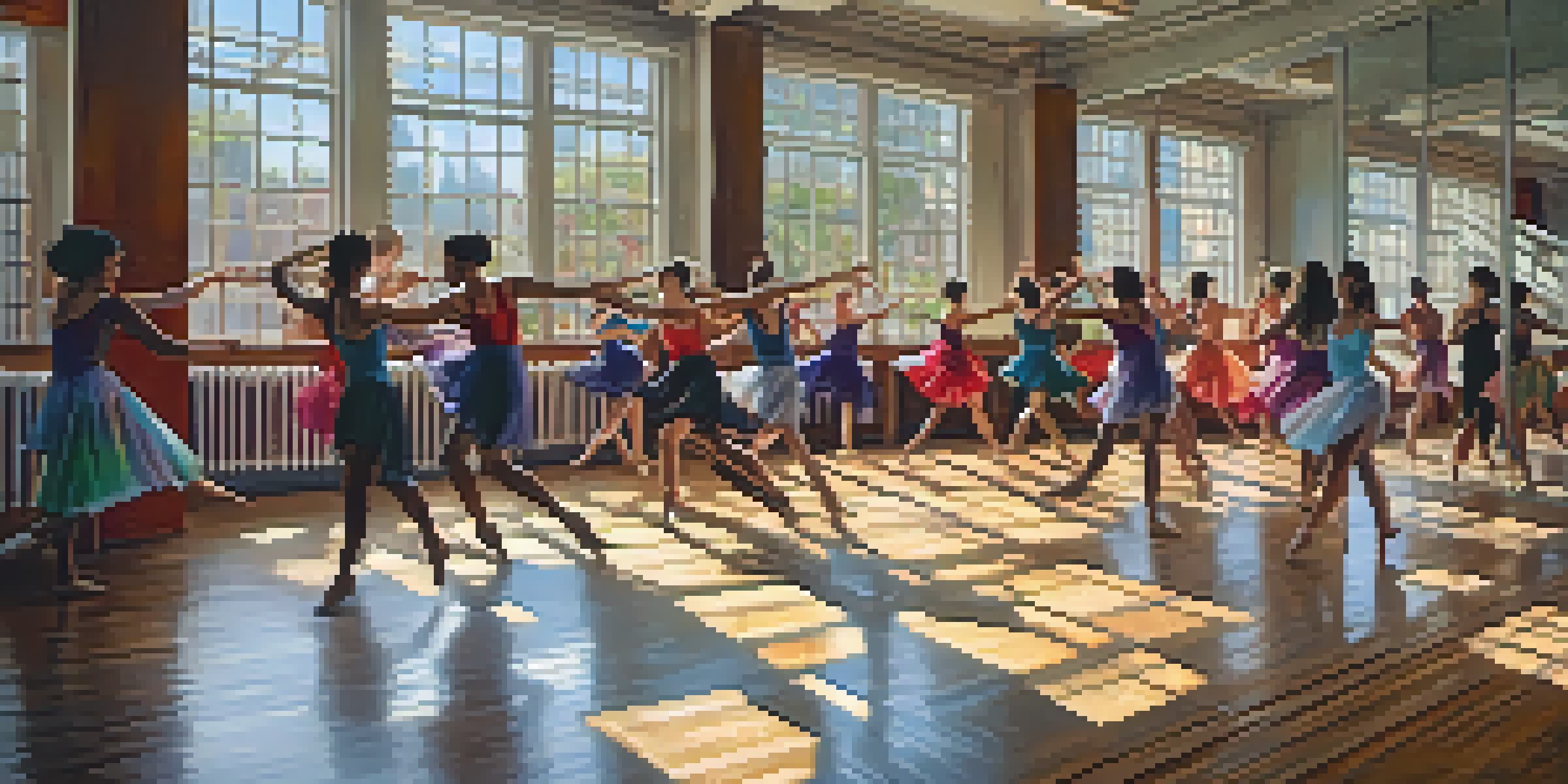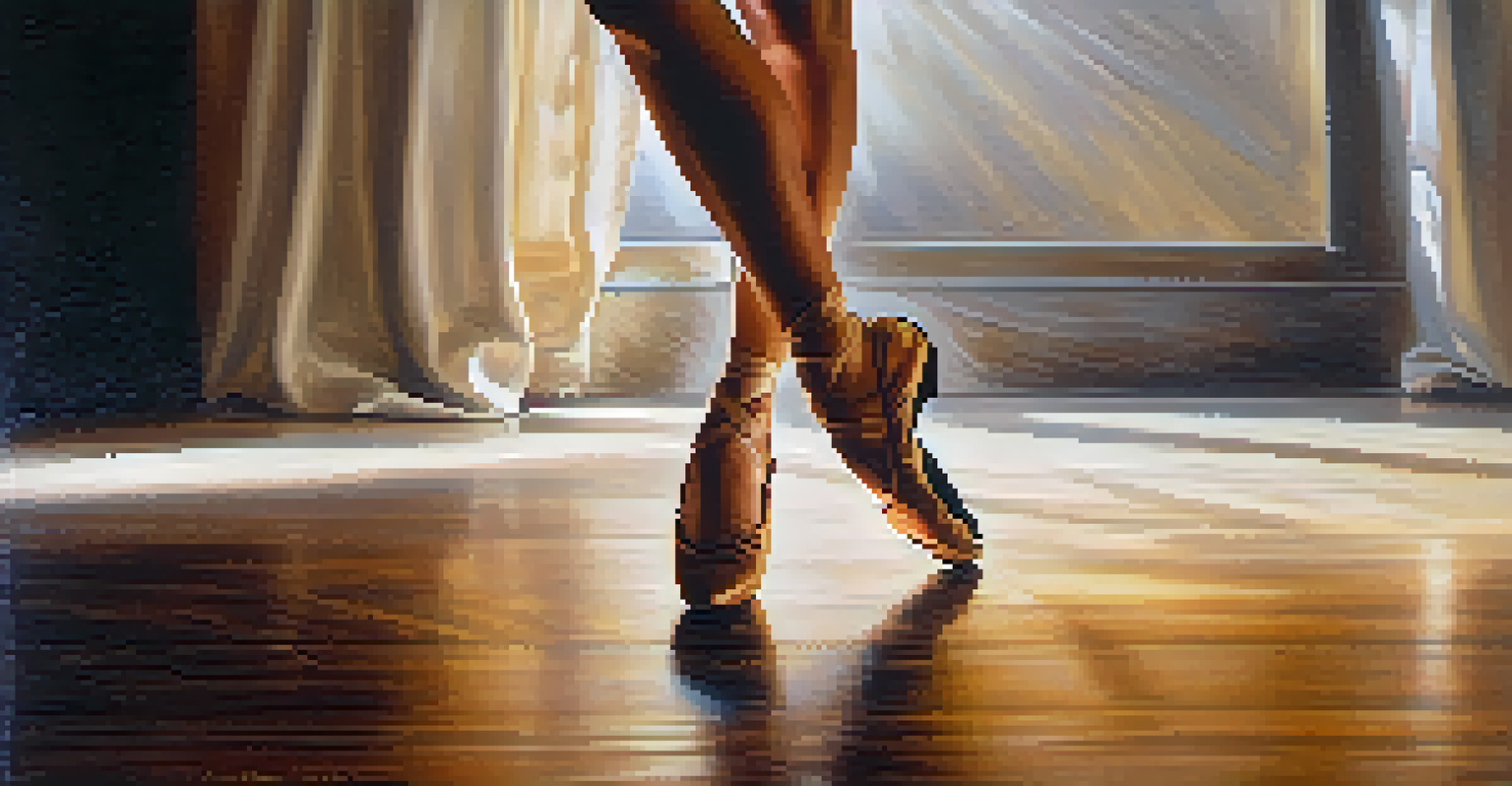Cultivating Spontaneity: Improvisation in Dance Practice

Understanding Improvisation in Dance Practice
Improvisation in dance is all about spontaneity and creativity. It allows dancers to express themselves without pre-set choreography, tapping into their instincts and emotions. This practice can take many forms, from free-form movement to structured improvisational exercises.
Dance is the hidden language of the soul.
When dancers improvise, they create a dialogue with their bodies and the space around them. This connection can lead to unexpected and beautiful movements that might never occur in a traditional class. Think of it as jazz music, where musicians riff off each other, creating something unique in the moment.
Improvisation encourages dancers to listen to their bodies and respond to their inner impulses. It’s a chance to break free from the constraints of routine and explore new avenues of expression, making dance feel alive and vibrant.
The Benefits of Improvisation for Dancers
One of the key benefits of improvisation is the boost it provides to creativity. When dancers let go of rigid structures, they open themselves up to new ideas and movement possibilities. This freedom can lead to innovative performances that captivate audiences.

Moreover, improvisation enhances a dancer's ability to adapt on the fly. Just like in life, things don’t always go as planned during a performance. Dancers who practice improvisation are often more resilient and confident in their ability to handle unexpected situations.
Improvisation Boosts Creativity
Dancers who embrace improvisation open themselves to new movement possibilities and innovative performances.
Additionally, improvisation fosters a deeper connection to one's body. Dancers learn to trust their instincts, developing a more intuitive understanding of their movements. This can be incredibly empowering, allowing for greater expression and authenticity in their dance.
Creating a Safe Space for Improvisation
Establishing a supportive environment is crucial for effective improvisation. Dancers need to feel safe to explore and express themselves without fear of judgment. This can be achieved through warm-up exercises that promote relaxation and openness.
The dance is a poem of which each movement is a word.
Group improvisation sessions can also build trust among dancers. When participants share the space, they learn to be vulnerable and open to each other's movements. This collective experience can spark creativity and lead to stronger connections within the group.
Instructors can play a significant role by encouraging exploration and celebrating unique movements. By fostering a positive atmosphere, they can help dancers feel empowered to take risks and discover their own style in improvisation.
Techniques to Enhance Improvisational Skills
There are several techniques dancers can use to improve their improvisational skills. One effective method is to incorporate prompts, such as a specific theme or emotion, to guide movement choices. These cues can spark ideas and help dancers focus their creativity.
Another technique is to explore different styles of music. Dancing to various genres can inspire new movements and interpretations. For instance, transitioning from classical music to hip-hop can lead to unexpected and exciting shifts in dance style.
Safe Spaces Enhance Exploration
Creating a supportive environment allows dancers to express themselves freely and fosters trust within the group.
Practicing solo improvisation is also beneficial. By dancing alone, individuals can explore their personal style without the influence of others. This self-exploration can build confidence and help dancers develop a unique voice in their improvisational practice.
Improvisation as a Tool for Personal Growth
Engaging in improvisation extends beyond dance; it can be a powerful tool for personal growth. By stepping out of their comfort zones, dancers learn to embrace uncertainty and develop resilience. This adaptability can translate to other areas of life, fostering a more open-minded approach to challenges.
Improvisation also encourages self-discovery. As dancers explore their movements, they often uncover hidden emotions and experiences. This process can lead to greater self-awareness and a deeper understanding of their unique artistic voice.
Furthermore, improvisation cultivates a sense of mindfulness. Dancers learn to be present in the moment, fully engaged with their bodies and surroundings. This heightened awareness can enhance overall well-being and contribute to a more fulfilling dance practice.
How Improvisation Influences Choreography
Improvisation is not only valuable in practice but also influences the choreography process. Many choreographers utilize improvisational techniques to generate new ideas and movement vocabulary. This spontaneous approach can lead to innovative and fresh choreography.
By incorporating improvisation into the creative process, choreographers can discover unexpected connections between movements. This often results in choreography that feels organic and fluid, capturing the essence of spontaneity that improvisation embodies.
Improvisation Aids Personal Growth
Engaging in improvisation helps dancers develop resilience, self-awareness, and mindfulness that extend beyond dance.
Moreover, dancers who are skilled in improvisation can contribute their unique perspectives to choreographed pieces. Their ability to think on their feet can infuse a performance with a sense of authenticity and energy, making the dance even more captivating.
Embracing Spontaneity in Dance Communities
Embracing spontaneity within dance communities fosters a vibrant and dynamic environment. When dancers feel encouraged to improvise, it creates a culture of creativity and exploration. This can lead to exciting collaborations and performances that highlight the unique voices of each dancer.
Community improvisation events, workshops, and jam sessions provide opportunities for dancers to connect and share their experiences. These gatherings can be a melting pot of ideas, where individuals inspire each other and push the boundaries of their art.

Ultimately, celebrating spontaneity in dance communities nurtures a sense of belonging and support. Dancers come together to celebrate their differences, fostering an inclusive space that values creativity and exploration in every form.